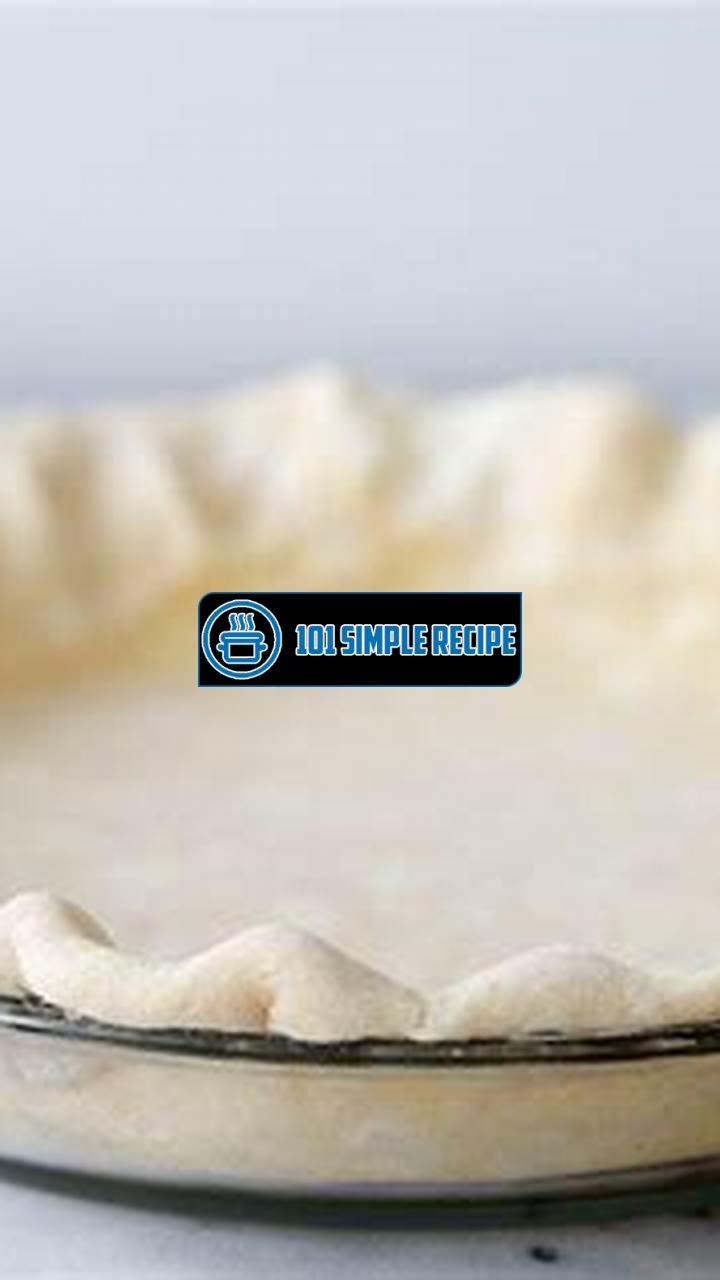Are you ready to take your pie baking skills to the next level? Look no further than the all butter crust for both sweet and savory pies, known as Pâte Brisée. This versatile and delicious crust is made with just a few simple ingredients, but the results are truly remarkable. Whether you’re whipping up a classic apple pie or experimenting with a savory quiche, Pâte Brisée will elevate your creations to new heights. The flaky texture and buttery flavor of this crust will have your friends and family begging for seconds. So let’s dive into the world of Pâte Brisée and discover the secrets behind its success.

The Versatile All Butter Crust
When it comes to pie crusts, the all butter crust reigns supreme. Whether you’re making a sweet or savory pie, this crust offers a delectable crunch and rich flavor that is simply irresistible. Its versatility makes it a go-to choice for bakers and pie enthusiasts alike.
One of the reasons why the all butter crust is so beloved is because it uses simple yet essential ingredients. By combining flour, butter, salt, and ice water, you can create a dough that is both flaky and tender. The key is to use high-quality butter that is cold and cut into small pieces. This will ensure that the crust has a buttery flavor and a light, delicate texture.
The art of mixing and chilling is another crucial step in achieving the perfect all butter crust. You want to mix the ingredients just until they come together and form a dough. Overmixing can lead to a tougher crust. Once the dough is formed, it’s important to chill it in the refrigerator for at least an hour. This allows the butter to firm up, which helps create those sought-after flaky layers.
When it comes to rolling out the dough, achieving the perfect thickness is key. You want the crust to be thin enough to provide structure and hold the filling, but not too thin that it becomes fragile and crumbly. Aim for a thickness of about 1/8 inch, ensuring that it is evenly rolled out.
The versatility of the all butter crust is truly unmatched. Whether you’re making a classic apple pie or a savory quiche, this crust can complement any filling with its buttery goodness. From sweet to savory, the all butter crust has got you covered.
In conclusion, the all butter crust is a must-have for anyone looking to create delicious pies. Its versatility, delectable crunch, and rich flavor are what set it apart from other crust options. So why not try your hand at making an all butter crust for your next sweet or savory pie? Your taste buds will thank you.
Mastering the Sweet Variations
Unlock the secrets to creating heavenly sweet pies using the all butter crust. Whether you prefer classic fruit fillings or decadent chocolate creations, this versatile crust is the perfect foundation for your dessert masterpieces. With its rich flavor and flaky texture, the all butter crust elevates any sweet pie to a whole new level of deliciousness.
Creating a Flaky Fruit Pie
Start by selecting the freshest seasonal fruits for your fruit pie. From juicy peaches to tangy berries, the options are endless. Wash and prepare the fruits, removing any pits, stems, or seeds. Next, prepare the all butter crust by combining flour, butter, sugar, and salt in a food processor. Pulse until the mixture resembles coarse crumbs.
Transfer the mixture to a large bowl and add ice water, a little at a time, while mixing gently. Continue adding water until the dough comes together and forms a ball. Be sure not to overmix, as this can result in a tough crust. Divide the dough in half and shape each half into a disk. Wrap in plastic wrap and refrigerate for at least 30 minutes.
Once the dough has chilled, roll out one disk on a lightly floured surface. Carefully transfer the rolled dough to a pie dish, ensuring it covers the bottom and sides. Add the prepared fruit filling, making sure to distribute it evenly. Roll out the second disk of dough and place it over the filling. Trim any excess dough and crimp the edges to seal the pie. Make a few slits on the top crust to allow steam to escape during baking.
Bake the pie in a preheated oven according to your specific recipe instructions. The result will be a golden, flaky crust that perfectly complements the sweet and juicy fruit filling. Serve the pie warm with a scoop of vanilla ice cream for a truly indulgent treat.
Indulgent Chocolate Delights
If you’re a chocolate lover, the all butter crust can also be used to create decadent chocolate pies. Start by melting your favorite high-quality chocolate in a heatproof bowl set over simmering water. Stir until smooth and let it cool slightly.
In a separate bowl, combine flour, cocoa powder, sugar, and salt. Cut cold butter into small pieces and add it to the dry ingredients. Use a pastry cutter or your fingertips to blend the butter into the flour mixture until it resembles coarse crumbs.
Slowly pour in the melted chocolate and mix until the dough comes together. Divide the dough into two portions, wrap in plastic wrap, and refrigerate for at least 1 hour.
Once chilled, roll out one portion of dough on a floured surface and transfer it to a pie dish. Fill the pie crust with your favorite chocolate filling, such as a rich ganache or a creamy chocolate mousse. Roll out the remaining dough and place it over the filling. Seal the edges and make decorative slits on the top crust.
Bake the chocolate pie according to your recipe’s instructions. The result will be a luscious, chocolatey dessert with a buttery, flaky crust that will impress any chocolate lover. Serve slices of the pie with a dollop of whipped cream and a sprinkle of cocoa powder for an extra touch of indulgence.
Creative Twists with Sweet Fillings
The all butter crust allows for endless creativity when it comes to sweet pie fillings. Think beyond the traditional fruit or chocolate options and experiment with unique flavor combinations and textures.
Consider adding a layer of creamy custard or a drizzle of caramel sauce to your fruit pie for an extra touch of indulgence. Sprinkle toasted nuts or coconut flakes over the filling for added crunch. You can even incorporate spices like cinnamon or nutmeg to enhance the overall flavor profile.
If you’re feeling adventurous, try adding a layer of tangy lemon curd to your chocolate pie or a swirl of peanut butter for a delightful surprise. The possibilities are truly endless when it comes to creating innovative and delicious sweet pies with the all butter crust.
So, next time you’re in the mood for a sweet treat, don’t settle for a generic store-bought pie crust. Master the art of creating heavenly sweet pies by using the all butter crust. With its flaky texture, rich flavor, and endless possibilities for customization, this crust will take your sweet pies to new heights of deliciousness!
Exploring Savory Sensations
Dive into the world of savory pies and learn how to elevate your all butter crust with a variety of mouthwatering fillings. Whether you’re a fan of meaty creations or prefer vegetarian options, there’s something for everyone to enjoy.
Savory Meat Pies that Wow
When it comes to savory pies, meat fillings offer a delicious and satisfying experience. The addition of a perfectly crafted all butter crust takes these pies to a whole new level. With the right combination of seasonings and fillings, you can create a masterpiece that will leave your taste buds dancing with joy.
One mouthwatering option is the classic beef and mushroom pie. The tender chunks of beef stewed in a rich gravy, complemented by the earthy flavors of mushrooms, create a savory delight. The buttery crust adds a flaky texture that perfectly balances the hearty filling.
If you’re looking for something with a bit of a kick, try a spicy chicken and vegetable pie. The combination of tender chicken, vibrant veggies, and a touch of spicy heat creates a flavor explosion in every bite. The all butter crust provides a perfect foundation for this bold and exciting filling. ️
For those with adventurous tastes, a lamb and feta pie is a must-try. The tender lamb, marinated in fragrant herbs, pairs beautifully with the tangy feta cheese. The all butter crust adds a luxurious touch to this unique and flavorful combination.
Vegetarian Delights with the All Butter Crust
Not a fan of meat? No problem! The all butter crust can be used to create mouthwatering vegetarian pies that are equally satisfying. With a wide variety of fresh vegetables and flavorful ingredients, you can create a pie that will impress even the most devoted carnivores.
A crowd-pleasing choice is the roasted vegetable and goat cheese pie. The caramelized flavors of roasted vegetables, combined with the creamy and tangy goat cheese, create a dish that is bursting with taste. The all butter crust provides a buttery and flaky base for this colorful and delicious pie.
If you’re craving something a bit more exotic, try a spinach and feta pie with a Mediterranean twist. The earthy spinach, salty feta cheese, and aromatic herbs will transport your taste buds to the sunny shores of Greece. With the all butter crust, every bite is a little taste of the Mediterranean.
For a burst of freshness, a tomato and basil pie is a perfect choice. The juicy tomatoes, fragrant basil, and a hint of garlic create a harmonious combination of flavors. The all butter crust adds a delightful crunch that perfectly complements the vibrant filling.
Amping Up the Flavor Profile
Ready to take your all butter crust to the next level? Here are some tips to amp up the flavor profile of your savory pies:
- Experiment with herbs and spices: Don’t be afraid to add a dash of your favorite herbs or spices to the filling for an extra burst of flavor.
- Try different cheese: Cheese can add depth and richness to your pie. Experiment with different varieties such as cheddar, Gruyere, or blue cheese.
- Add a touch of sweetness: Balancing the savory flavors with a touch of sweetness can create a more complex and interesting taste. Consider adding a sprinkle of brown sugar or a drizzle of honey.
- Play with textures: In addition to a flaky crust, consider adding some crunch to your pie. You can sprinkle breadcrumbs or nuts on top before baking for a delightful texture contrast.
With these tips and ideas, you’ll be able to create savory pies that will wow your family and friends. Remember, the all butter crust is the foundation of a delicious pie, so make sure to give it the attention it deserves. Happy baking!
Troubleshooting Tips for Success
Working with an all butter crust for sweet and savory pies, known as pâte brisée, can be a delightful experience. The buttery, flaky texture adds a delicious touch to any pie. However, like any baking endeavor, there are common challenges that may arise. In this article, we will explore three common issues faced when working with an all butter crust and provide expert advice on how to overcome them for flaky perfection.
Avoiding a Soggy Bottom
One of the most dreaded problems when it comes to pie crusts is a soggy bottom. This occurs when moisture from the filling seeps into the crust, resulting in a less-than-ideal texture. To avoid this, there are a few key steps you can take:
- Pre-bake the crust: Blind baking the crust for a short period of time before filling it helps create a barrier between the crust and the filling. This allows the crust to partially cook and form a sturdy base.
- Egg wash: Brushing the crust with an egg wash before adding the filling can also help create a protective layer that prevents excessive moisture absorption.
- Thickening agents: Incorporating ingredients such as cornstarch or flour into the filling can help absorb excess liquid and prevent it from seeping into the crust.
By following these tips, you can ensure your all butter crust remains delightfully crisp and free from a soggy bottom.
Preventing Shrinkage and Cracking
Another common challenge when working with an all butter crust is shrinkage and cracking. These issues can be frustrating, but with a few techniques, you can overcome them:
- Chill the dough: After preparing the crust, allow it to chill in the refrigerator for at least 30 minutes. This helps relax the gluten and prevents excessive shrinkage during baking.
- Proper rolling technique: Roll out the dough evenly and avoid overstretching it. This can lead to cracking or shrinkage. Roll from the center outward and rotate the dough periodically to ensure an even thickness.
- Patching cracks: If cracks do occur, don’t panic! Simply use a small piece of dough to patch them up. Press the dough gently over the cracks and smooth it out.
By following these steps, you can achieve a beautifully unshrunken and crack-free all butter crust.
Dealing with Crumbly Crust
A crumbly crust can be challenging to work with, but fear not! There are methods to combat this issue and achieve a tender and cohesive crust:
- Proper hydration: Ensure that you’re adding enough liquid to the dough. Butter-based crusts tend to be drier, so don’t hesitate to add a bit more water or other liquid as needed to achieve the right consistency.
- Rest and chill: Allow the dough to rest in the refrigerator for at least 1 hour before rolling it out. This allows the gluten strands to relax and prevents the dough from crumbling when rolled.
- Gentle handling: When rolling and transferring the dough, handle it with care. Overworking the dough can lead to a crumbly texture. Be gentle and avoid excessive manipulation.
- Binding agents: Adding an egg yolk or a tablespoon of sour cream can help improve the texture and bind the dough together. These ingredients add moisture and elasticity to the crust.
By incorporating these techniques, you can transform a crumbly crust into one that holds together beautifully, resulting in a pie that is both visually appealing and delightfully delicious.
Getting Creative with Decorative Techniques
Are you ready to take your pie presentation to the next level? Adding decorative techniques to your all butter crust for sweet and savory pies will not only make your creations visually stunning but also impress your guests with your culinary skills. Let’s explore various decorative techniques that will elevate your pie presentation for a show-stopping finish.
The Art of Lattice Design
One of the most classic and elegant ways to decorate your all butter crust is by creating a lattice design. To achieve this beautiful pattern, roll out your pie dough and cut it into long, thin strips using a sharp knife or a pastry wheel. Lay half of the strips horizontally across the top of your pie filling, leaving a small gap between each strip. Fold back every other strip, and then place a strip vertically across the unfolded strips. Next, unfold the folded strips back over the newly placed strip. Repeat this process, alternating the folded and unfolded strips until you have created a lattice pattern across the entire pie. Trim the excess dough, and press the edges to seal. This technique not only looks impressive but also allows the filling to peek through, enticing your guests with a sneak peek of the deliciousness inside.
Impressive Cut-Out Patterns
If you want to add a touch of whimsy to your pies, try incorporating cut-out patterns into your all butter crust. This technique allows you to create fun and decorative shapes on the top of your pie. To achieve this, roll out your dough and use cookie cutters or a sharp knife to cut out shapes. You can create anything from stars and hearts to leaves and flowers, depending on the theme of your pie. Arrange the cut-out shapes on top of your pie filling, and press the edges to seal. The cut-out patterns will not only make your pie visually appealing but also provide a delicious and crispy texture to the crust.
Intriguing Crust Edges and Seals
The edges and seals of your pie crust can serve as the perfect canvas for creativity. Instead of simply crimping the edges, try experimenting with different crust edge designs to add a touch of uniqueness to your pies. You can create a braided edge by weaving thin strips of dough together or make a scalloped edge using a fluted pastry wheel. Another option is to use a fork to press decorative patterns around the edges. Additionally, don’t forget to decorate the seal where the top and bottom crusts meet. You can use a fork to press a decorative pattern or create a rope-like design by twisting small strips of dough. These small details will make your pie look professionally crafted and irresistible.
In conclusion, mastering various decorative techniques for your all butter crust will not only enhance the visual appeal of your sweet and savory pies but also show off your culinary expertise. The art of lattice design, impressive cut-out patterns, and intriguing crust edges and seals are just a few techniques you can explore to elevate your pie presentation. So go ahead and unleash your creativity, and prepare to wow your guests with delicious and visually stunning pies. Happy baking!
Thank you for taking the time to read our article on All Butter Crust for Sweet and Savory Pies – Pâte Brisée. We hope you found the information and tips helpful in perfecting your pie crust skills. We encourage you to visit our website again in the future for more delicious recipes and baking inspiration. Remember, a homemade pie crust made with all butter is the secret ingredient to truly exceptional pies. Happy baking!
Frequently Asked Questions
Here are some frequently asked questions about All Butter Crust for Sweet and Savory Pies – Pâte Brisée:
| No. | Questions | Answers |
|---|---|---|
| 1. | Can I use other fats instead of butter? | Yes, you can use other fats such as lard or shortening, but the all butter crust gives the pies a rich and flavorful taste. |
| 2. | Can I make the dough in advance and refrigerate it? | Absolutely! In fact, chilling the dough for at least an hour before rolling it out can help achieve a flakier crust. |
| 3. | Can I freeze the dough for later use? | Yes, you can freeze the dough for up to 3 months. Just make sure to wrap it tightly in plastic wrap before placing it in the freezer. |
| 4. | Should I blind bake the crust before adding the filling? | It depends on the recipe. For custard or fruit-filled pies, blind baking the crust can help prevent a soggy bottom. However, for savory pies, it’s not always necessary. |
| 5. | Can I use this crust recipe for tarts? | Yes, this all butter crust recipe works well for both pies and tarts. Just adjust the size of the dough accordingly. |
| 6. | Can I add sugar to this crust recipe for sweet pies? | Yes, you can add a tablespoon or two of sugar to the dough if you prefer a slightly sweeter crust for your sweet pies. |
All Butter Crust for Sweet and Savory Pies – Pâte Brisée: A Perfectly Flaky Crust Every Time
Mastering the art of pie crust is a game-changer when it comes to creating delectable sweet and savory pies. With our All Butter Crust recipe, you can achieve a buttery, flaky crust that will elevate your pies to new heights. Whether you’re making a classic apple pie or a savory quiche, the all butter crust is the foundation for success. So, roll up your sleeves, grab your rolling pin, and let’s get baking. Don’t forget to visit our website again for more baking inspiration and recipes that will leave you craving for more. Happy baking!
Jump to Recipe
All Butter Crust for Sweet and Savory Pies – Pâte Brisée

Learn how to make the perfect all butter crust for both sweet and savory pies. This flaky and buttery crust will take your pies to the next level.
- 2 1/2 cups all-purpose flour
- 1 teaspoon salt
- 1 teaspoon sugar
- 1 cup unsalted butter (cold and cubed)
- 4-6 tablespoons ice water
- In a large bowl, whisk together the flour, salt, and sugar.
- Add the cold cubed butter to the flour mixture. Use a pastry cutter or your fingers to cut the butter into the flour until the mixture resembles coarse crumbs.
- Gradually add the ice water, 1 tablespoon at a time, while tossing the mixture with a fork. Continue adding water until the dough starts to come together.
- Turn the dough out onto a lightly floured surface and gently knead it a few times to bring it together into a smooth dough.
- Divide the dough in half and shape each half into a disc. Wrap them in plastic wrap and refrigerate for at least 1 hour before rolling out.
- Once chilled, roll out the dough on a lightly floured surface to fit your pie dish. Transfer the rolled dough to the dish and trim any excess.






